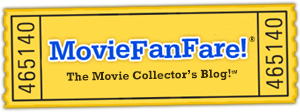
Everyone has heard how the first prime time animated TV series, 1960’s The Flintstones from Hanna-Barbera, was inspired by Jackie Gleason’s seminal sitcom The Honeymooners. One year later, the studio did it again, adapting The Phil Silvers Show, aka Sergeant Bilko, into Top Cat. But did you know that, also in 1961, the creators of Leave It to Beaver decided to enter the cartoon genre with a show based on one of radio’s most controversial programs?
Debuting on ABC in October of 1961 and airing for just one season, Calvin and the Colonel was set in a large city populated by talking animals. Taking center stage were the title duo: an easy-going bear, Calvin T. Burnside, and his best friend Col. Montgomery J. Klaxon, a smooth-talking Southern fox who regularly coaxed his ursine pal into one money-making pipe dream after another. Also there to put the kibosh on the Colonel’s schemes were his long-suffering wife Maggie Belle and her spinster sister Sweet Sue, who lived with the couple.
 This all sounds innocuous enough, until one learns that the show was an animalized translation of Amos ‘n’ Andy, a radio comedy featuring white actors (creators Freeman Gosden and Charles Correll) portraying Black characters who spoke in minstrel show dialect. Broadcast by CBS from 1928 to 1960 in various formats, Amos ‘n’ Andy was one of the most popular shows on the air for decades. This was in spite of complaints and protests over how it often depicted African-Americans. The series’ success led to a 1930 feature film, Check and Double Check, starring Gosden and Correll in blackface (they also lent their voices to two early ’30s cartoon shorts). And there was a 1951-53 CBS TV series where the leads were played by Black actors Alvin Childress and Spencer Williams, with Tim Moore as the conniving George “Kingfish” Stevens. When their radio show ended in November of 1960, Gosden and Correll looked for a way to continue the characters they had developed over many years, but in a less derogatory format.
This all sounds innocuous enough, until one learns that the show was an animalized translation of Amos ‘n’ Andy, a radio comedy featuring white actors (creators Freeman Gosden and Charles Correll) portraying Black characters who spoke in minstrel show dialect. Broadcast by CBS from 1928 to 1960 in various formats, Amos ‘n’ Andy was one of the most popular shows on the air for decades. This was in spite of complaints and protests over how it often depicted African-Americans. The series’ success led to a 1930 feature film, Check and Double Check, starring Gosden and Correll in blackface (they also lent their voices to two early ’30s cartoon shorts). And there was a 1951-53 CBS TV series where the leads were played by Black actors Alvin Childress and Spencer Williams, with Tim Moore as the conniving George “Kingfish” Stevens. When their radio show ended in November of 1960, Gosden and Correll looked for a way to continue the characters they had developed over many years, but in a less derogatory format.
Enter producers Joe Connelly and Bob Mosher. The duo had worked as writers on the Amos ‘n’ Andy radio and TV shows for over a decade and from there branched out in feature films (1955’s The Private War of Major Benson, with Charlton Heston). Two years later, they created and produced the classic family sitcom Leave It to Beaver for Universal’s Revue Studios.
Working with ABC and Revue’s Kayro-Vue branch, Connelly and Mosher came up with an animated series that would substitute Calvin for Amos Jones, the Colonel for the Kingfish, and Maggie Belle for Kingfish’s wife, Sapphire (Andy Brown’s character had become secondary by that point). After all, many of Hanna-Barbera’s toon stars had voices and mannerisms borrowed from stage, radio, and film comedians, so the premise seemed foolproof. A first-season sponsorship deal with Lever Brothers was struck, and the show premiered on October 3, 1961, the same week that two other comedies, The Dick Van Dyke Show and Mister Ed, made their network prime time debuts.

While Mister Ed and Dick Van Dyke were both ratings hits, Calvin and the Colonel, to put it simply, was not. After just two months ABC pulled the plug on the show. Thanks to Lever Brothers’ sponsorship, the network revived it in a Saturday evening slot in January of 1962, where it finished up its first and only season. The 26 episodes would be seen briefly on Saturday mornings, then in syndication, before fading into the animation afterworld. It did manage to score some merchandising tie-ins, from two issues of a Dell comic book to a board game, a coloring book, and other items.
So, how was Calvin and the Colonel as a cartoon series? If you were very young–like me–when it aired and had no idea of its problematic origins, it reminded you of such Southern-fried toon stars as Foghorn Leghorn and Deputy Dawg, or perhaps the “Pogo” comic strip. The borrowed scripts were standard sitcom fare, with occasional physical humor to hold kids’ attention. Its animation, co-directed by Warner Bros. veteran Charles McKimson, was nothing special, and while the show was made in color ABC broadcast it in black-and-white (no pun intended). Along with Gosden and Correll, the voice cast included Paul Frees, Virginia Gregg, and Beatrice Kay, with guest spots by June Foray, Joe Flynn, Frank Nelson, and Jesse White, among others.
After the show ended, Gosden and Correll retired to Beverly Hills, where they lived a few blocks apart. Correll died in 1972, with Gosden passing away a decade later. As for Connelly and Mosher, they would strike pop culture gold in 1964 as the producers of the CBS “monstercom” The Munsters. Fun Fact: In the Season Two Munsters episode “A Visit from Johann,” a clip from Calvin and the Colonel can briefly be seen on a TV set.

